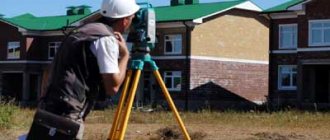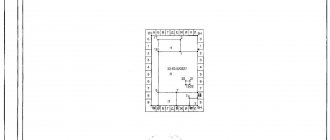Any land plot entered into the state real estate register must be registered in the cadastral register and have its own unique cadastral number, which is assigned once and cannot be changed, even if it is sold or inherited.
But in rare cases, situations may arise that require changing this code, due to which the owner will need to perform many prompt and labor-intensive actions.
In what cases may it be necessary to change or cancel the Civil Code of Ukraine?
The list of conditions that imply the possibility of changing or canceling the cadastral number is contained in Federal Law No. 221, which is dedicated to the state real estate cadastre. Clause 3 of Article 16 lists cases in which it is necessary to change this code:
- Changing the storage address or description of its location.
- Combining a plot with neighboring ones or vice versa, dividing it into several parts (that is, any change in area).
Thus, any amendments to the Civil Code are made only when the properties and characteristics of the site have changed. A change of owner does not fall into these cases.
After changing the cadastral number, the old one loses its validity, that is, it is canceled and is not intended for identification in the future (how such a code is initially obtained is described in a separate material).
The initiative to change the code can come from both the owner himself and Rosreestr employees.
Rosreestr employees have the right to cancel the cadastral number not only after it has been changed, but also if the rights to the land plot, after its registration, have not been properly legalized within 5 years.
Is the State Tax Code changing and how?
To replace the cadastral number, first of all, you need to contact a geodetic organization , which will carry out land surveying work on the land plot and, upon completion, will issue the owner with the appropriate document.
Afterwards, the owner must contact Rosreestr at the location of the site (in person or through an authorized representative) and submit the following set of documents:
- Passport.
- Document on completed land surveying work.
- Power of attorney (if the documents are not submitted by the owner of the land plot).
- Extract from the Unified State Register (whether they are still issued, we tell you here).
- Extract from the Unified State Register of Real Estate (how to get it, read here).
- Proof of ownership.
- Technical plan and permission for use (if new built objects have appeared on the site).
- Decision of municipal authorities (if the address of the storage facility has changed).
- A statement containing:
- registry data;
- reasons for changing the cadastral code;
- Full name of the owner or authorized representative;
- passport data;
- consent to the processing of personal data;
- list of attached documentation;
- date of drawing up the application with signature.
A receipt of paid state duty is required to be provided only if, in addition to changing the number, the owner’s data changes.
After reviewing the documents, the owner of the land plot receives a corresponding certificate with a new cadastral code.
The period for reviewing documents is no more than 5 days from the moment they are submitted; if in addition a new owner is registered, the procedure will take 10 days.
On our website you can also familiarize yourself with materials from which you will learn how the cadastral number of a plot is used to determine its address and owner.
How to change the cadastral number?
Rosreestr maintains state records of real estate in Russia. This is where you need to go to make changes. The application is submitted to the territorial office of Rosreestr at the location of the land plot. You can find out the addresses of regional offices and authorized branches for accepting applications directly on the department’s website.
Other ways to make changes is to transfer documents through the MFC or by Russian post. Rosreestr also allows you to send an application in electronic format through the website.
The documents required from the applicant to amend the State Tax Code will depend on the specific situation. This list may include:
- Applicant's passport and power of attorney to represent interests (optional).
- An extract from the Unified State Register of Real Estate (it must, among other things, confirm the ownership rights to the applicant’s land).
- Boundary plan and cadastral passport.
- The administration’s decision to change the address, transfer land, clarify their intended use.
- Technical plan for the located buildings.
In any case, the owner will be required to fill out an application form for making changes. It can be filled out directly during a visit to Rosreestr or in advance. The application must include:
- name of the Rosreestr body;
- the reason that prompted the owner to make changes (what characteristics of the site have changed);
- information about the applicant;
- list of attached documents;
- consent to the processing of personal data;
- preferred method of receiving a decision on the application (in person, by mail or through a representative).
You can apply here.
The edits themselves are made free of charge. The state duty is paid only if the owner needs to obtain a new extract from the Unified State Register of Real Estate.
The department will have 18 days to change the number and make amendments to the State Tax Code. But when submitting an application by mail or through the MFC, the specified deadlines can be extended by the time the notification is delivered by the postal service or MFC couriers up to 21-25 days. Land owners will always be able to track the status of application processing online using the number issued to them.
During the specified time frame, the owner may be refused to register changes (for example, if factual errors and inaccuracies are found, or documents are incomplete).
How does liquidation take place?
If the owner of the land plot became aware of the cancellation of the cadastral number and its exclusion from the State Property Committee, this will mean that the plot was not properly legalized. To avoid unpleasant consequences, the owner of the land needs to register the plot with the Register as soon as possible in order to legitimize his rights. This procedure consists of several stages:
- Collect the necessary package of documents (passport, land survey plan, application). The list of documentation is not final and may be supplemented depending on the reasons for cancellation and the specifics of existing changes.
- With the collected package of documents, contact the register or MFC (documents can also be sent electronically to the State Services portal). Review of documents may take up to ten days; if necessary, center staff may request additional clarifying information.
- Based on the results of the check and completion of the entire process, receive an extract from the Unified State Register of Real Estate (you can learn about the form of this document and the information it contains from this article).
That is, the owner must re-register the land, since restoring data from the State Property Committee is impossible.
When going through this procedure, you must pay a state fee, the amount of which can range from 350 to 2000 rubles.
The cadastral number allows you not only to carry out various transactions with the land plot (sale, donation, etc.) without problems and consequences, but also, if necessary, you can use it to find out the fact of registration and various key information.
Algorithm of actions to eliminate cadastral errors in the location of the boundaries of a land plot
A cadastral error in information occurs due to erroneous data specified in the documents on the basis of which the property was registered in the cadastral register or in the information about it. Thus, such an error does not depend on the actions of the cadastral registration authority. For a land plot, this may include incorrectly indicated boundaries, rotation angles, and location.
Pensioner Valentina Semenovna Petrova faced this problem.
Question: My plot, according to the coordinates provided by the Cadastral Chamber, occupies a third of the neighbor’s plot, but we have not moved the fences since we received ownership of the land in the 90s. The neighbor considers his boundaries to be correct, and so do I, because both of us surveyed and paid a lot of money for it back in 2005. On our street, I heard that we were not the only ones in this situation. And everyone has the same problem: in order to correct the boundaries in their area, all the neighbors on the whole street need to move. But we don’t find any solution, we just quarrel every time we go out to garden.
Deputy Director - Chief Technologist of the Branch of the Cadastral Chamber of the Chuvash Republic Alexandrova Nina Nikolaevna:
Answer: Such a problem really exists and its scale cannot be accurately determined unless the owners themselves take the necessary actions to identify such cases. The legislator recognized situations where the actual boundaries do not correspond to the described border coordinates in the state real estate cadastre as cadastral errors.
The reason for their occurrence is quite banal - incorrect coordination of the boundaries of one of the plots on the street, information about which the subsequent surveyor, who carried out cadastral work on neighboring plots, used as initial data. Even if the fact of an incorrect boundary was established, a method for documenting the error and mechanisms for correcting it did not exist until 03/01/2008. During this time, the number of errors increased day by day.
But a solution to this problem has already been provided and is effective enough to bring cadastre information into line with the actual boundaries between previously recorded land plots. The only condition for this is the will of all owners, expressed in the agreement of new (correctly established) boundaries that correspond to those that are actual and understandable to all neighbors for many years, and not with errors in coordinates. Since today only cadastral engineers can carry out such work and prepare the documents necessary for accounting, filing claims against survey organizations that made mistakes in 2005 or earlier (later) will not bring any results, since many of them have already ceased their activities and make claims There is simply no one to complain about the quality of work, and the statute of limitations for making such claims has expired.
However, bringing information about the location of boundaries (coordinates of characteristic points of these boundaries) into accordance with actual boundaries (fences, boundaries, perennial plantings and other artificial and natural boundary signs), in the opinion of the Branch, is an important task for land owners. After all, every piece of land, like any thing that can be bought - sold, donated, transferred for use (rent) should not be defective, and incorrectly determined coordinates of such a unique characteristic as boundaries are the very defects of the work of land surveyors many years ago, which entrusted with this work requiring elimination. Today, it can only be corrected by qualified specialists - cadastral engineers, who are responsible for their reputation and the right to carry out this activity and bear administrative and criminal responsibility for the quality of their work, which (responsibility) was not previously provided for. Moreover, identifying errors, investigating their causes and resolving the issue of correction by mutual consent of neighbors - adjacent plots - was not previously provided for in the laws. Such issues could only be resolved in court by challenging the survey results.
Today, you can also sue your neighbors, but you need to clearly assess your capabilities, both financial and time, and understand that going to court will require bearing the burden of proving that you are right, will create an artificial conflict with a neighbor who has been named as a defendant, and may require hiring a lawyer to the defense of the right was qualified and took a long time to participate in litigation, manipulation of terms understandable to specialists in the field of geodesy or jurisprudence, proceedings in land management forensic examinations, the payment of which is assigned by the court to the parties to the process. Or you can simply and clearly two or more neighbors for a fee much less than legal costs and much faster and more efficiently correct cadastral errors in the procedure for recording changes by agreeing on the changes by everyone. For many years, practicing cadastral engineers have known how to prepare a boundary plan to correct a cadastral error in the location of boundaries and how to justify the reasons for their presence.
The only warning from the Branch, both owners and cadastral engineers, is that manipulations with the substitution of a cadastral error in the procedure for redistribution or squatting of public lands can quickly be detected and sent to supervisory authorities for investigation. Therefore, everyone must be conscientious in correcting cadastral errors, not look for those responsible, but follow a clearly defined legal scheme for eliminating them.










